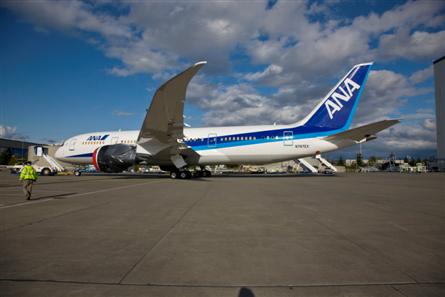Rolls-Royce is preparing to power the Boeing 787's service entry with All Nippon Airways, scheduled for the third quarter, as it simultaneously starts work on a third package of improvements for the Trent 1000 aimed at the stretched -9 variant of the aircraft.
Although certificated at a thrust rating of 74,000lb (330kN) in 2007, the "Package A" version of the Trent 1000 is rated at 64,000lb and will equip only the first four ANA 787-8s. The Japanese carrier's fifth 787 - the first to be operated on international routes and due to be delivered at the end of the year - will introduce the Package B version of the engine rated at 70,000lb.
"Going into service we're confident we've got a mature product that's had a lot of engineering work and issues fixed, and a lot of flight-test experience," says Trent 1000 programme director Simon Carlisle. "Clearly the [787] programme has gone much slower than we would have liked, and the engine would have been ready back in 2007. I guess we'll never know what that would have meant."
 |
|---|
© Boeing |
He adds: "No doubt, where we are today we've got a more reliable product, because we've had time to do a ton more testing on it."
The Trent 1000 has accumulated more than 1,000 flights and over 2,800 flight hours, and flight testing of the first Package B engine began in May. Package B re-optimises the fan system around a different nozzle geometry, due to an earlier change in the thrust requirement for the 787. Also revised is the air system and low-pressure turbine (LPT).
Trent 1000 chief engineer Andy Geer says: "I don't think it's any secret that both engine companies on the 787 programme adopted a very similar style of LPT - high lift, short, low weight, and both of us have had some challenges in getting full aerodynamic efficiency out of that. So we've both done an iteration of the design. Package B gets us back within 1% of [fuel burn] specification."
The UK manufacturer is working with Boeing and ANA to ensure a smooth service entry for the 787.
"I guess that will really start to feel real around the beginning of July when Boeing starts to do route proving," says Carlisle. "They'll take the aircraft to Japan and do a ton of testing. We're absolutely treating that as if it was active service."
He acknowledges that lessons were learned from the introduction of the Trent 900, powering the Airbus A380, in 2007.
"We've got higher levels of support stationed around the world. Initially it's quite straightforward for us because it's all Japan and domestic for the first few months. Once ANA take their first international aircraft then we'll start putting support into Europe and the west coast of North America. That's people, assets and spare parts backed up by the operations centre in Derby and Boeing's operational centre in Seattle."
Carlisle also stresses the importance of getting the company's public relations strategy right.
"The thing we're very cognisant of from the A380 is being on top of communicating with the media. We're expect intense media interest in the aircraft. You can be sure that any squawk or cough will get a lot of attention, so we've been spending time on making sure that we will be in a position to handle that in the correct way," he says.
R-R and rival General Electric - offering its GEnx turbofan for the 787 - have split the market roughly equally in terms of numbers of customers, although GE leads in terms of aircraft numbers.
Geer says the Trent 1000 is within a "cigarette paper" of matching the GEnx on fuel burn, but the Trent's three shaft architecture will pay dividends in terms of better performance retention.
"Most of the focus on fuel consumption is on new engines," he says. "An engine is new once in its life and it spends the rest of its 24 years and 364 days not new and you should be more worried about its deterioration characteristics.
He adds: "Over the full life, our experience is that the three-shaft engine is significantly better. But it's not always easy to sell that in advance."
Another feature of the Trent 1000 is its intermediate pressure shaft electrical power offtake, which helps to reduce fuel consumption with the engine running at idle, particularly beneficial for short flight cycles.
Next up are Package C improvements for the 787-9.
"We've just been going through our concept close-out review, so we're moving into the detailed design phase for the parts that will go into Package C," says Geer. "The Package C programme has moved around a bit so we'll continue to tune when we deliver those solutions to best match the aircraft we are delivering."
Further away is Boeing's proposed -10X double-stretch, which would see the introduction of an extensively improved Trent 1000 which would then be offered across all three models of the 787 family.
"We're just starting that conversation with Boeing so they're in the process of defining the aircraft and we're working closely with them to decide what the engine requirements are," says Carlisle. "At the moment all of that fits well within the capabilities of the Trent 1000. One of our desires is to take some of the learning we're getting from the XWB and feed that back into the 1000. We see these engines very much as sisters. Technology-wise they're very equal, despite their different architectures.
"Our goal here is to make sure that when we do that, we design an engine that covers the whole family. Once Boeing nail down their requirements for the -10X then we'll respond with our offering for the whole family."
R-R has begun manufacturing Package B Trent 1000s, which will power ANA's longhaul 787s
The Package B engine features a re-optimised fan system
- All the latest news, images and video from the 2011 Paris air show
Source: Flight Daily News
















